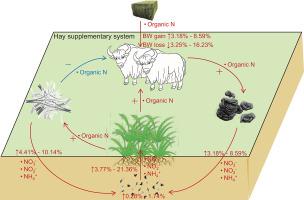Agricultural Systems ( IF 6.6 ) Pub Date : 2021-07-09 , DOI: 10.1016/j.agsy.2021.103216 Chuntao Yang 1 , James Peter Millner 2 , Yi Sun 1 , Hang Yuan 1 , Yang Liu 1 , Yan Zhang 1 , Zhaofeng Wang 1 , Shenghua Chang 1 , Fujiang Hou 1

|
CONTEXT
A large number of field trials assessing supplementary feeding have been conducted on the Qinghai-Tibet Plateau but its influence on nitrogen (N) cycling particularly N addition to soil through litter or dung deposition and the effect on soil N levels remain poorly understood.
OBJECTIVE
Here we investigated the effects of oat hay supplementation on forage biomass, N return from litter and dung to soil and soil N levels by comparing supplemented and non-supplemented systems.
METHODS
The non-supplemented system of yak was based on typical native grazing practices and was established in 2010. Grazing in supplementary feeding system was identical but each yak received oat hay (0.5, 1.0 or 1.5 kg/day, dry matter basis) during the cold season. For each system, forage biomass, N return from litter and dung to soil, and soil N levels were measured from 2010 to 2014.
RESULTS AND CONCLUSIONS
The results showed that supplementation systems increased 12.8% of forage biomass and enhanced N return from litter and dung to soil by 8.0% and 6.2%, respectively, compared with native grazing systems, but did not change soil N stock. Forage biomass (slope, 0.596 to 1.769) and return of N from litter to the soil (slope, 0.359 to 0.677) increased significantly as the trial progressed in supplementation systems. Increased forage biomass resulted in increased N uptake offsetting the supplement-induced soil N input resulting in minimal change in soil N.
SIGNIFICANCE
The conceptual framework firstly quantized the effect size of supplementary regime on N cycling of grazing systems and soil N levels in alpine meadows. It can be used for an essential model and extended to other agroecosystem that show the influence of external disturbances on nutrient cycling.
中文翻译:

用燕麦干草补充饲喂牦牛改善青藏高原高寒草甸氮循环
语境
已经在青藏高原进行了大量评估补充饲喂的田间试验,但其对氮(N)循环的影响,特别是通过凋落物或粪便沉积向土壤中添加的氮以及对土壤 N 水平的影响仍知之甚少。
客观的
在这里,我们通过比较补充和未补充系统,研究了燕麦干草补充剂对草料生物量、凋落物和粪便向土壤和土壤 N 水平的返回的影响。
方法
牦牛的非补充系统基于典型的本地放牧实践,于 2010 年建立。补充喂养系统中的放牧是相同的,但每头牦牛在寒冷期间接受燕麦干草(0.5、1.0 或 1.5 公斤/天,干物质基础)季节。对于每个系统,从 2010 年到 2014 年测量了草料生物量、从凋落物和粪便返回土壤的 N 以及土壤 N 水平。
结果和结论
结果表明,与天然放牧系统相比,补充系统增加了 12.8% 的牧草生物量,增加了凋落物和粪便向土壤的氮返回量分别增加了 8.0% 和 6.2%,但没有改变土壤 N 库。随着试验在补充系统中的进展,草料生物量(斜率,0.596 至 1.769)和氮从凋落物返回土壤(斜率,0.359 至 0.677)显着增加。牧草生物量增加导致氮吸收增加,抵消了补充诱导的土壤氮输入,导致土壤氮的变化最小。
意义
该概念框架首先量化了补充制度对高寒草甸放牧系统氮循环和土壤氮水平的影响大小。它可用于基本模型并扩展到其他农业生态系统,显示外部干扰对养分循环的影响。



























 京公网安备 11010802027423号
京公网安备 11010802027423号